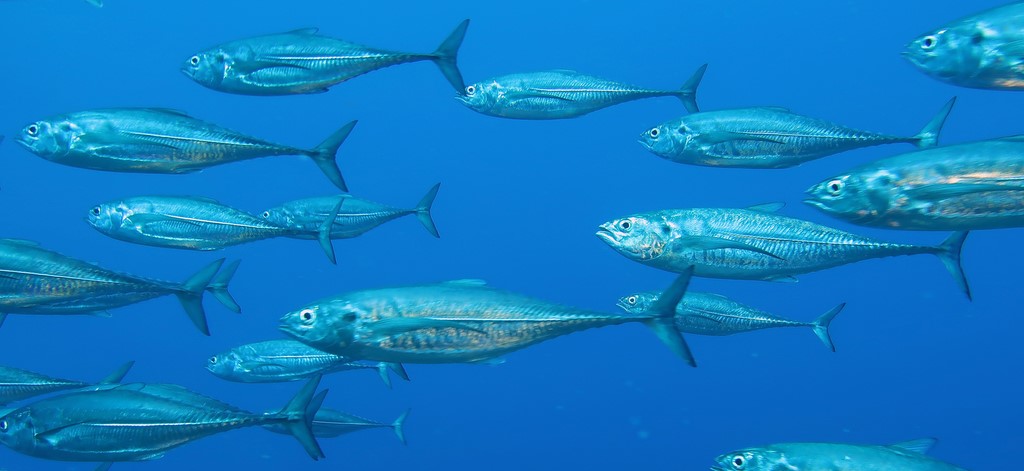MEGALASPIS CORDYLA - (LINNAEUS, 1758)
Picture courtesy of: Alain Daoulas
Actinopterygii (Gigaclass) > Actinopteri (Class) > Teleostei (Subclass) > Carangiformes (Order) > Carangoidei (Suborder) > Carangidae (Family) > Caranginae (Subfamily) > Megalaspis (Genus)
Carangue à bouclier, Finny scad, Finletted mackerel scad, Hardtail scad, Torpedo scad, Macarela torpedo, Oni-aji, オニアジ, Ko-dǔng-ga-ra-ji, 고등가라지, 大甲鰺, 鉛灰裸胸鰺,
Synonymes
Caranx besselii (Agassiz, 1874)
Caranx rottleri (Bloch, 1793)
Citula plumbea (Quoy & Gaimard, 1825)
Magalaspis cordyla (Linnaeus, 1758)
Megalapsis cordyla (Linnaeus, 1758)
Megalaspis cordylaa (Linnaeus, 1758)
Pleiopterus besselii (Agassiz, 1874)
Scomber cordyla (Linnaeus, 1758)
Scomber guara (Lacepède, 1800)
Scomber rottleri (Bloch, 1793)
----------------------
Description
Actinopterygii (Gigaclass) > Actinopteri (Class) > Teleostei (Subclass) > Carangiformes (Order) > Carangoidei (Suborder) > Carangidae (Family) > Caranginae (Subfamily) > Megalaspis (Genus)
Carangue à bouclier, Finny scad, Finletted mackerel scad, Hardtail scad, Torpedo scad, Macarela torpedo, Oni-aji, オニアジ, Ko-dǔng-ga-ra-ji, 고등가라지, 大甲鰺, 鉛灰裸胸鰺,
Synonymes
Caranx besselii (Agassiz, 1874)
Caranx rottleri (Bloch, 1793)
Citula plumbea (Quoy & Gaimard, 1825)
Magalaspis cordyla (Linnaeus, 1758)
Megalapsis cordyla (Linnaeus, 1758)
Megalaspis cordylaa (Linnaeus, 1758)
Pleiopterus besselii (Agassiz, 1874)
Scomber cordyla (Linnaeus, 1758)
Scomber guara (Lacepède, 1800)
Scomber rottleri (Bloch, 1793)
----------------------
Description
Dorsal spines (total): 9; Dorsal soft rays (total): 18-20, posterior: 7-9 rays consisting of semi-detached finlets; Anal spines: 3; Anal soft rays: 16-17, posterior: 8-10 rays semi-detached; Gill rakers (including rudiments): 8-11 upper, 18-22 lower and 26-32 total on first gill arch; Shoulder girdle (cleithrum) margin smooth, without papillae. Lateral line strongly arched anteriorly, with junction of curved and straight parts below 4th or 5th spine of dorsal fin; Chord of curved part of lateral line contained: 3.6-4.7 times in straight part (to caudal base); Scales in curved part of lateral line: 21-28; Straight part: 51-59 very large scutes. Body elongate, subcilindrical, a little compressed posteriorly, and with caudal peduncle strongly compressed with a marked medial keel. Snout and lower jaw pointed with a single row of small teeth, except a narrow band anteriorly; Upper jaw extending posteriorly to centre of eye with small villiform teeth, outer teeth moderately enlarged. Eye moderate, with well developed adipose eyelid completely covering eye except for a vertical slit centred on pupil. Caudal peduncle strongly compressed with a marked medial keel. Adipose eyelid well developed, leaving a slit at middle of eye. Scales on straight lateral line totally developed into extremely deep scutes. Breast naked ventrally and laterally in a triangular area for about one third distance to pectoral fin base. Max. length: 80.0 cm TL, common length: 45.0 cm TL. Max. published weight: 4.0 kg; Max. reported age: 5 years. Depth range: 1 - 100 m.
Color
Head and body bluish to green dorsally, sides and belly silvery; Large black opercular spot. Dorsal and anal fins pale to yellow, distally dusky; Pectoral and pelvic fins pale, with upper half dusky. Caudal fin dark, especially leading and trailing edges of fin.
Head and body bluish to green dorsally, sides and belly silvery; Large black opercular spot. Dorsal and anal fins pale to yellow, distally dusky; Pectoral and pelvic fins pale, with upper half dusky. Caudal fin dark, especially leading and trailing edges of fin.
Etymology
Megalaspis: from ancient Greek, mégas = great, large, mighty + from ancient Greek, aspis = heavy wooden shield. Referring to 51-59 very large keeled scales (or scutes) on straight portion of lateral line.
cordyla: name dating to Pliny the Elder’s Naturalis historia (77-79 AD), given to the fry of tunnies that enter the Black Sea from the Mediterranean to spawn; why Linnaeus applied this name for a species he erroneously believed occurred in America (actually Red Sea and Indo-West Pacific) is not known.
Original description: Scomber cordyla Linnaeus, 1758 - Type locality: America (in error). If Neotype is accepted: Riau, Selat Riau, Indonesia.
Distribution
Red Sea; Indo-West Pacific: KwaZulu-Natal (South Africa), East Africa and Persian Gulf east to Marshall Islands and Samoa, north to southern Korea and southern Japan, south to Western Australia, New South Wales (Australia), New Caledonia and Tonga.
Megalaspis: from ancient Greek, mégas = great, large, mighty + from ancient Greek, aspis = heavy wooden shield. Referring to 51-59 very large keeled scales (or scutes) on straight portion of lateral line.
cordyla: name dating to Pliny the Elder’s Naturalis historia (77-79 AD), given to the fry of tunnies that enter the Black Sea from the Mediterranean to spawn; why Linnaeus applied this name for a species he erroneously believed occurred in America (actually Red Sea and Indo-West Pacific) is not known.
Original description: Scomber cordyla Linnaeus, 1758 - Type locality: America (in error). If Neotype is accepted: Riau, Selat Riau, Indonesia.
Distribution
Red Sea; Indo-West Pacific: KwaZulu-Natal (South Africa), East Africa and Persian Gulf east to Marshall Islands and Samoa, north to southern Korea and southern Japan, south to Western Australia, New South Wales (Australia), New Caledonia and Tonga.
Biology
Adults are primarily oceanic, pelagic schooling species rarely seen on reefs. They feed mainly on fishes. Generally marketed fresh.
Last update: 7, March 2023
Adults are primarily oceanic, pelagic schooling species rarely seen on reefs. They feed mainly on fishes. Generally marketed fresh.
Last update: 7, March 2023
